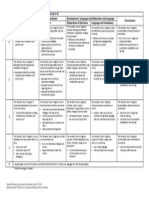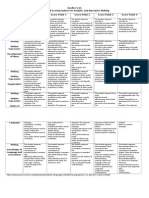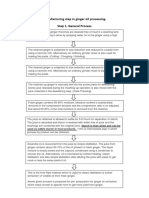Smarter Balanced Informative Rubric
Smarter Balanced Informative Rubric
Uploaded by
mrsjpryorCopyright:
Available Formats
Smarter Balanced Informative Rubric
Smarter Balanced Informative Rubric
Uploaded by
mrsjpryorCopyright
Available Formats
Share this document
Did you find this document useful?
Is this content inappropriate?
Copyright:
Available Formats
Smarter Balanced Informative Rubric
Smarter Balanced Informative Rubric
Uploaded by
mrsjpryorCopyright:
Available Formats
Sample Generic 4-point Informative-Explanatory Writing Rubric (Grade 6-11) Statement of Purpose/Focus and Organization Development: Language and
Elaboration of Evidence Score Statement of Organization Elaboration of Evidence Language and Vocabulary Purpose/Focus
The response is fully sustained and consistently and purposefully focused: controlling idea or main idea of a topic is focused, clearly stated, and strongly maintained controlling idea or main idea of a topic is introduced and communicated clearly within the context The response has a clear and effective organizational structure creating unity and completeness: use of a variety of transitional strategies logical progression of ideas from beginning to end effective introduction and conclusion for audience and purpose strong connections among ideas, with some syntactic variety The response provides thorough and convincing support/evidence for the controlling idea or main idea that includes the effective use of sources, facts, and details. The response achieves substantial depth that is specific and relevant: use of evidence from sources is smoothly integrated, comprehensive, and concrete effective use of a variety of elaborative techniques The response adequately expresses ideas, employing a mix of precise with more general language use of domain-specific vocabulary is generally appropriate for the audience and purpose The response clearly and effectively expresses ideas, using precise language: use of academic and domain-specific vocabulary is clearly appropriate for the audience and purpose
Conventions
The response demonstrates a strong command of conventions: few, if any, errors are present in usage and sentence formation effective and consistent use of punctuation, capitalization, and spelling
The response is adequately sustained and generally focused: focus is clear and for the most part maintained, though some loosely related material may be present some context for the controlling idea or main idea of the topic is adequate
The response has an evident organizational structure and a sense of completeness, though there may be minor flaws and some ideas may be loosely connected: adequate use of transitional strategies with some variety adequate progression of ideas from beginning to end adequate introduction and conclusion adequate, if slightly inconsistent, connection among ideas
The response provides adequate support/evidence for the controlling idea or main idea that includes the use of sources, facts, and details. some evidence from sources is integrated, though citations may be general or imprecise adequate use of some elaborative techniques
The response demonstrates an adequate command of conventions: some errors in usage and sentence formation may be present, but no systematic pattern of errors is displayed adequate use of punctuation, capitalization, and spelling
The response is somewhat sustained and may have a minor drift in focus: may be clearly focused on the controlling or main idea but is insufficiently sustained controlling idea or main idea may be unclear and somewhat unfocused
The response has an inconsistent organizational structure, and flaws are evident: inconsistent use of transitional strategies with little variety uneven progression of ideas from beginning to end conclusion and introduction, if present, are weak weak connection among ideas
The response provides uneven, cursory support/evidence for the controlling idea or main idea that includes partial or uneven use of sources, facts, and details: evidence from sources is weakly integrated, and citations, if present, are uneven weak or uneven use of elaborative techniques
The response expresses ideas unevenly, using simplistic language: use of domain-specific vocabulary that may at times be inappropriate for the audience and purpose
The response demonstrates a partial command of conventions: frequent errors in usage may obscure meaning inconsistent use of punctuation, capitalization, and spelling
The response may be related to the topic but may provide little or no focus:
The response has little or no discernible organizational structure: few or no transitional strategies are evident frequent extraneous ideas may intrude
may be very brief may have a major drift focus may be confusing or ambiguous
The response provides minimal support/evidence for the controlling idea or main idea that includes little or no use of sources, facts, and details: use of evidence from the source material is minimal, absent, in error, or irrelevant
The response expression of ideas is vague, lacks clarity, or is confusing: uses limited language or domainspecific vocabulary may have little sense of audience and purpose
The response demonstrates a lack of command of conventions: errors are frequent and severe and meaning is often obscure
A response gets no credit if it provides no evidence of the ability to (fill in with any key language from the intended target).
Smarter Balanced Assessment Consortium, April 16, 2012 Reformatted by CIE Services, Clackamas Education Service District
Smarter Balanced Assessment Consortium, April 16, 2012 Reformatted by CIE Services, Clackamas Education Service District
You might also like
- Azmerit Writing Rubric - OpinionDocument2 pagesAzmerit Writing Rubric - Opinionapi-261833732No ratings yet
- Smarter Balanced Argumentative RubricDocument1 pageSmarter Balanced Argumentative Rubricmrsjpryor100% (1)
- ELA Argumentative Performance Task: Full-Write EssayDocument3 pagesELA Argumentative Performance Task: Full-Write Essayapi-250945637No ratings yet
- Wsii RubricDocument3 pagesWsii Rubricapi-278321671No ratings yet
- WritingDocument1 pageWritingapi-262368305100% (1)
- Ela Annotated Informative RubricDocument2 pagesEla Annotated Informative Rubricapi-261363827No ratings yet
- Ccss RubricDocument1 pageCcss Rubricapi-285976570No ratings yet
- Smarter Balanced Assessment Consortium:: English Language Arts RubricsDocument27 pagesSmarter Balanced Assessment Consortium:: English Language Arts RubricsJosé Del SolarNo ratings yet
- 4th Grade Writing Scoring Key IW 4Document3 pages4th Grade Writing Scoring Key IW 4MaricaRhoneNo ratings yet
- Expository RubricDocument1 pageExpository RubrickristenfusaroNo ratings yet
- Ela-Writing-Rubrics-6-11 InformativeDocument8 pagesEla-Writing-Rubrics-6-11 Informativeapi-216580282No ratings yet
- Tnready Rubric Info-Expl gr6-8Document1 pageTnready Rubric Info-Expl gr6-8api-293560724No ratings yet
- Infexp State Rubric-Gr6-8Document1 pageInfexp State Rubric-Gr6-8api-234796756No ratings yet
- Literary Analysis RubricDocument2 pagesLiterary Analysis Rubricapi-284934486100% (1)
- Writing RubricsDocument4 pagesWriting RubricsAliana Cruz GonzalesNo ratings yet
- 4 Jcps Scoring ContinuumDocument2 pages4 Jcps Scoring Continuumapi-233206923No ratings yet
- Assessment Criteria To The Oral PresentationsDocument2 pagesAssessment Criteria To The Oral PresentationsElom de PauloNo ratings yet
- Rubric For EssayDocument2 pagesRubric For Essaypavlosmakridakis2525No ratings yet
- TOEFL Ibt Writing RubricsDocument2 pagesTOEFL Ibt Writing RubricsSereg LeiteNo ratings yet
- Writing RubricDocument1 pageWriting Rubricapi-278673581No ratings yet
- Spanish Listening & Reading RubricDocument1 pageSpanish Listening & Reading RubricTeryn OdomNo ratings yet
- Informative-Explanatory Essay Writing Guide (Grades 3-5) : Purpose, Focus, and Organization Evidence and ElaborationDocument1 pageInformative-Explanatory Essay Writing Guide (Grades 3-5) : Purpose, Focus, and Organization Evidence and Elaborationapi-273649873No ratings yet
- Appendix G: Report Writing Criteria Content Organization Style / LanguageDocument6 pagesAppendix G: Report Writing Criteria Content Organization Style / LanguageoguzcryNo ratings yet
- PersuadeforchangerubricDocument1 pagePersuadeforchangerubricapi-325343869No ratings yet
- Revised Socratic Seminar RubricDocument1 pageRevised Socratic Seminar Rubricapi-263744910No ratings yet
- Opinion Essay Writing Guide (Grades 3-5) : Purpose, Focus, and Organization Evidence and ElaborationDocument1 pageOpinion Essay Writing Guide (Grades 3-5) : Purpose, Focus, and Organization Evidence and Elaborationapi-273649873No ratings yet
- RubricDocument1 pageRubricCatherine Magpantay-MansiaNo ratings yet
- Honors College: Rubric For The Written Thesis (Uh 450) Date, Time, Honors LoungeDocument4 pagesHonors College: Rubric For The Written Thesis (Uh 450) Date, Time, Honors LoungePilar 'Phie' S. CaparasNo ratings yet
- Toefl Ibt Writing Rubrics Enhanced - 230913 - 212549Document2 pagesToefl Ibt Writing Rubrics Enhanced - 230913 - 212549Ahmet Emin AKKUŞNo ratings yet
- Toefl Ibt Writing Rubrics Enhanced - 230913 - 2128Document2 pagesToefl Ibt Writing Rubrics Enhanced - 230913 - 2128Ahmet Emin AKKUŞNo ratings yet
- 1tu0-4h-Rms-20220825 KopyasıDocument14 pages1tu0-4h-Rms-20220825 KopyasıAs 54bdNo ratings yet
- Oral Presentation RubricDocument1 pageOral Presentation RubricPali Prado PinedaNo ratings yet
- FSA ELA Writing Rubric: Grade 8Document4 pagesFSA ELA Writing Rubric: Grade 8Adriana PaolaNo ratings yet
- Speaking Skills - Indicators, Assessment, and Personalised GoalsDocument8 pagesSpeaking Skills - Indicators, Assessment, and Personalised GoalsillumeschoolNo ratings yet
- Grade 6-11 Constructed Response RubricDocument2 pagesGrade 6-11 Constructed Response Rubricapi-254108669No ratings yet
- Relatedness To Question/topicDocument2 pagesRelatedness To Question/topicJamaica Cruz San PedroNo ratings yet
- Diag Rubric Port-801405Document2 pagesDiag Rubric Port-801405msbrennerNo ratings yet
- Grade 6 ELA Unit4 Benchmark Assessment RubricDocument2 pagesGrade 6 ELA Unit4 Benchmark Assessment RubricBecky JohnsonNo ratings yet
- Opinion Rubric Grades 6-8Document1 pageOpinion Rubric Grades 6-8api-301014041No ratings yet
- Exhibition Rubric 2010 54Document1 pageExhibition Rubric 2010 54api-257082219No ratings yet
- RubricDocument1 pageRubricapi-298547770No ratings yet
- Smarter Balanced Narrative RubricDocument1 pageSmarter Balanced Narrative RubricmrsjpryorNo ratings yet
- NCSSM Diagnostic RubricDocument2 pagesNCSSM Diagnostic RubricCharles ZhaoNo ratings yet
- EssayrubricDocument2 pagesEssayrubricapi-261532064No ratings yet
- Opargrubric gr6 8Document1 pageOpargrubric gr6 8api-234796756No ratings yet
- Scoring Rubrics PDFDocument3 pagesScoring Rubrics PDFcarlos801No ratings yet
- Sample Activity Evaluation Form QuestionsDocument3 pagesSample Activity Evaluation Form QuestionsAnaly BacalucosNo ratings yet
- Performance Task Part 2 RubricDocument2 pagesPerformance Task Part 2 Rubricapi-298162516No ratings yet
- CommunicationDocument12 pagesCommunicationvarshasdm1987No ratings yet
- Expanded Scoring Rubric For Analytic and Narrative WritingDocument2 pagesExpanded Scoring Rubric For Analytic and Narrative Writingapi-302874825No ratings yet
- RubricDocument1 pageRubricapi-281771432No ratings yet
- MYP Language B Standard Assessment CriteriaDocument9 pagesMYP Language B Standard Assessment Criteriasahil_309No ratings yet
- Oral Presentation RubricDocument1 pageOral Presentation Rubricapi-290160874No ratings yet
- Speaking RubricDocument1 pageSpeaking RubricxespejoNo ratings yet
- Independent WRITING RubricsDocument3 pagesIndependent WRITING RubricsDeepak MashruNo ratings yet
- Holistic Writing Rubric For The Short Constructed Response TaskDocument4 pagesHolistic Writing Rubric For The Short Constructed Response TasksudanworkshopNo ratings yet
- LMSW Exam Prep 2024 - 2025 Complete Study Guide for the ASWB Masters for Social Work Licensing + Top Test Questions and Answers to Pass the ExamFrom EverandLMSW Exam Prep 2024 - 2025 Complete Study Guide for the ASWB Masters for Social Work Licensing + Top Test Questions and Answers to Pass the ExamNo ratings yet
- Mastering CELPIP Speaking: Strategies, Tips, and Practice for SuccessFrom EverandMastering CELPIP Speaking: Strategies, Tips, and Practice for SuccessRating: 5 out of 5 stars5/5 (1)
- Smarter Balanced Narrative RubricDocument1 pageSmarter Balanced Narrative RubricmrsjpryorNo ratings yet
- The 50-Book Challenge Requirements and Checklist (By Genre)Document1 pageThe 50-Book Challenge Requirements and Checklist (By Genre)mrsjpryorNo ratings yet
- The 50/50 Challenge Reading Tracking SheetDocument1 pageThe 50/50 Challenge Reading Tracking SheetmrsjpryorNo ratings yet
- ISN Directions ELADocument3 pagesISN Directions ELAmrsjpryorNo ratings yet
- 50-Book Challenge Requirements and Checklist (By Genre)Document2 pages50-Book Challenge Requirements and Checklist (By Genre)mrsjpryorNo ratings yet
- Expert Seminar Handout 7th GradeDocument3 pagesExpert Seminar Handout 7th GrademrsjpryorNo ratings yet
- 8 Grade Cotillion Ball: ScheduleDocument1 page8 Grade Cotillion Ball: SchedulemrsjpryorNo ratings yet
- 8th Grade Book Challenge Planning SheetDocument1 page8th Grade Book Challenge Planning SheetmrsjpryorNo ratings yet
- 8th Grade Book Challenge Planning SheetDocument1 page8th Grade Book Challenge Planning SheetmrsjpryorNo ratings yet
- ELA Grade 7 Course Syllabus 2012-2013Document3 pagesELA Grade 7 Course Syllabus 2012-2013mrsjpryorNo ratings yet
- Reading ListDocument2 pagesReading ListmrsjpryorNo ratings yet
- How To Turn Your Stacks of Notecards Into An OutlineDocument4 pagesHow To Turn Your Stacks of Notecards Into An OutlinemrsjpryorNo ratings yet
- Cotillion Ball InformationDocument1 pageCotillion Ball InformationmrsjpryorNo ratings yet
- Ancient HistoryDocument60 pagesAncient Historyn.ploegmanNo ratings yet
- EJMCM - Volume 9 - Issue 7 - Pages 8448-8453 PDFDocument6 pagesEJMCM - Volume 9 - Issue 7 - Pages 8448-8453 PDFVijayakumarNo ratings yet
- KARAN KHODE RESUME E4yearsDocument2 pagesKARAN KHODE RESUME E4yearswooden makersNo ratings yet
- Pengaruh Pemberian Probiotik Lactobacillus Acidophilus Dan Bifidobacterium Terhadap Produksi Ayam Petelur Yang Diinfeksi Escherichia ColiDocument7 pagesPengaruh Pemberian Probiotik Lactobacillus Acidophilus Dan Bifidobacterium Terhadap Produksi Ayam Petelur Yang Diinfeksi Escherichia ColiMuhammad Dzaky AlhurryNo ratings yet
- Diel Alder ReportDocument7 pagesDiel Alder Reportjnane200650% (2)
- Tugas PhonologyDocument4 pagesTugas PhonologyRizqi RamseyNo ratings yet
- The History of Discovery, Synthesis and Development of Testosterone For Clinical UseDocument12 pagesThe History of Discovery, Synthesis and Development of Testosterone For Clinical UseQuinn CRNo ratings yet
- Cirrus 6000 User ManualDocument542 pagesCirrus 6000 User ManualJhonatanJaramilloNo ratings yet
- Hobart Welding Class 3ooDocument34 pagesHobart Welding Class 3oocamby22629No ratings yet
- SYLLABUS - ELECTIVE PAPER PHDDocument3 pagesSYLLABUS - ELECTIVE PAPER PHDRaghavendra PrasadNo ratings yet
- SporTrak Base enDocument74 pagesSporTrak Base enMatt StubbinsNo ratings yet
- CE-700 Working Group Initial Cessna 180Document7 pagesCE-700 Working Group Initial Cessna 180Elmer VillegasNo ratings yet
- SampleDocument4 pagesSampleJustin Jones NotarteNo ratings yet
- Manufacturing Step in Ginger Oil ProcessingDocument3 pagesManufacturing Step in Ginger Oil ProcessingmilindNo ratings yet
- Sleep Worksheet - 01 - Sleep DiaryDocument1 pageSleep Worksheet - 01 - Sleep DiaryCláudia AlmeidaNo ratings yet
- PrincessTheHopeful PDFDocument432 pagesPrincessTheHopeful PDFShanaynayNo ratings yet
- Amerta Sari - TOO & ENOUGHDocument2 pagesAmerta Sari - TOO & ENOUGHKetut Siti Amerta SariNo ratings yet
- The GaudiumDocument8 pagesThe GaudiumThe High School for Girls PotchefstroomNo ratings yet
- Threshold 14Document192 pagesThreshold 14Vikshade100% (4)
- Communication Skills in Pharmacy Practice Communication Skills in Pharmacy PracticeDocument13 pagesCommunication Skills in Pharmacy Practice Communication Skills in Pharmacy PracticeyousernameNo ratings yet
- MIMSDocument2 pagesMIMSDivyaDevadasAnvekarNo ratings yet
- Wiring Diagram Rear SAM Sheet 1Document8 pagesWiring Diagram Rear SAM Sheet 1alexmtzgNo ratings yet
- Philippine National Bank, Plaintiff-Appellant, vs. Jose C. ZuluetaDocument46 pagesPhilippine National Bank, Plaintiff-Appellant, vs. Jose C. ZuluetaLavin AguilarNo ratings yet
- People Vs KalaloDocument1 pagePeople Vs KalaloShiela PilarNo ratings yet
- Data Sheet Sensors VEK S4 S4CDocument2 pagesData Sheet Sensors VEK S4 S4Cbadeaioana70No ratings yet
- VorticismDocument4 pagesVorticismKarina Alvarado MattesonNo ratings yet
- 2024 January StatementDocument1 page2024 January Statementcontact.sindicateNo ratings yet
- Second Division: Republic of The Philippines Court of Tax Appeals Quezon CityDocument11 pagesSecond Division: Republic of The Philippines Court of Tax Appeals Quezon CityDennise TalanNo ratings yet
- What Is The Significance of Tented Vias PCBDocument7 pagesWhat Is The Significance of Tented Vias PCBjackNo ratings yet
- A Posteriori A Priori Ad HocDocument10 pagesA Posteriori A Priori Ad HocAila Jean PascualNo ratings yet





































































































